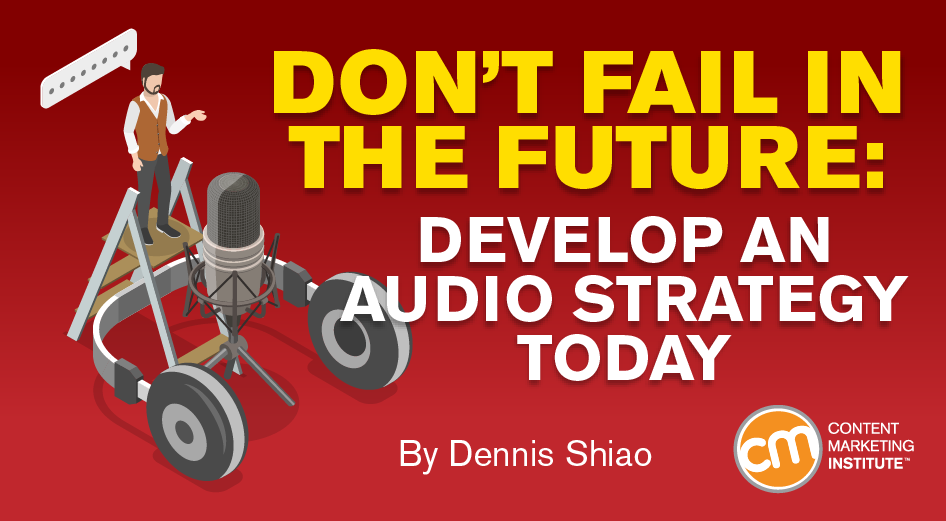As content marketers, we create experiences that connect with our target audience. Our content marketing strategy is seemingly sound. Audio. He delivered a presentation at Content Marketing World, Developing a Holistic Audio Content Strategy. Why content marketers need an audio content strategy Podcasting is not a holistic audio content strategy. Discover the sound of your brand “A brand that has a sound and has a holistic strategy for it becomes a friend quicker than a brand that is only experienced by text,” Tom says. People voice their symptoms. But now you can just tell the Amazon Echo.” That brief interaction with WebMD also can accrue brand preference and brand loyalty with the audience. Be entertaining, be a show While people are listening to more podcasts, the supply is growing faster than the ability to consume them. If you can hear me now, it means that you’re on board with the “why” for an audio content strategy.

As content marketers, we create experiences that connect with our target audience. By forming these connections, we increase brand perception and preference, lower barriers, and eliminate objections.
Ultimately, we want our content marketing to drive positive business outcomes and brand loyalty. Each month, we busily work away at our content calendar: blog posts, contributed articles, webinars, infographics, white papers, and more.
Our content marketing strategy is seemingly sound. What could it be missing?
Audio.
According to Tom Webster, senior vice president, strategy and marketing at Edison Research, audio is a powerful medium underused by content marketers. Tom notes that the path to brains via the ears (i.e., sound) is faster than the path through the eyes (i.e., sight).
It’s a more primal path. “When you hear a baby cry or when you hear someone scream, it instantly goes into your brain and you understand that this is something that is grabbing you on multiple levels,” Tom says.
He delivered a presentation at Content Marketing World, Developing a Holistic Audio Content Strategy. In this article, you can learn the key takeaways from Tom’s presentation.
Why content marketers need an audio content strategy
Podcasting is not a holistic audio content strategy. It’s a start, but a comprehensive strategy goes well beyond it. Let’s consider the data Tom shared to convince us of the need for an audio strategy.
Edison Research and Triton Digital produce an annual report, Infinite Dial, which provides “the latest research in digital audio, social media, mobile, smart speakers, and podcast consumption.”
The 2018 Infinite Dial study shows that two-thirds of the country listened to some form of digital audio in the previous month (e.g., Spotify, Pandora, podcasts). Over 22% of the United States (about 73 million people) listened to a podcast in the previous month.
Edison Research measures the devices people use to consume audio content, a concept called Share of Ear®. Over the past few years, according to Tom, podcasts have overtaken AM-FM radio for the Share of Ear.
“That’s a significant change in human behavior,” he says. Marketers can take advantage of that shift. While it’s hard to get our content on terrestrial radio, there’s nothing stopping us from launching a podcast.
Audio also is a convenient way to consume content. With a printed book, you are limited to times when you can sit down and read it. With audio, you can consume the book while sitting and moving, whether it’s the walk to lunch or a drive to work.
Appreciate growth in smart speaker adoption
An Edison Research-NPR report found that almost one in five Americans say they own a smart speaker. That’s nearly tripled year over year, which is the fastest growing technology we have ever tracked in 20 years. Faster than smartphones, faster than digital audio, and faster than podcasting,” Tom says.
About 43% of respondents said they purchased the smart speaker specifically to reduce screen time. It makes sense – using your voice to ask a question or take an action is easier than typing or tapping a keyboard.
What does this mean for the future?
Audio will grow as the prevailing medium, especially as audio-enabled technology is further embedded in cars, household appliances, and other devices used daily.
Now, let’s consider important elements of your audio content strategy.
Discover the sound of your brand
“A brand…

COMMENTS